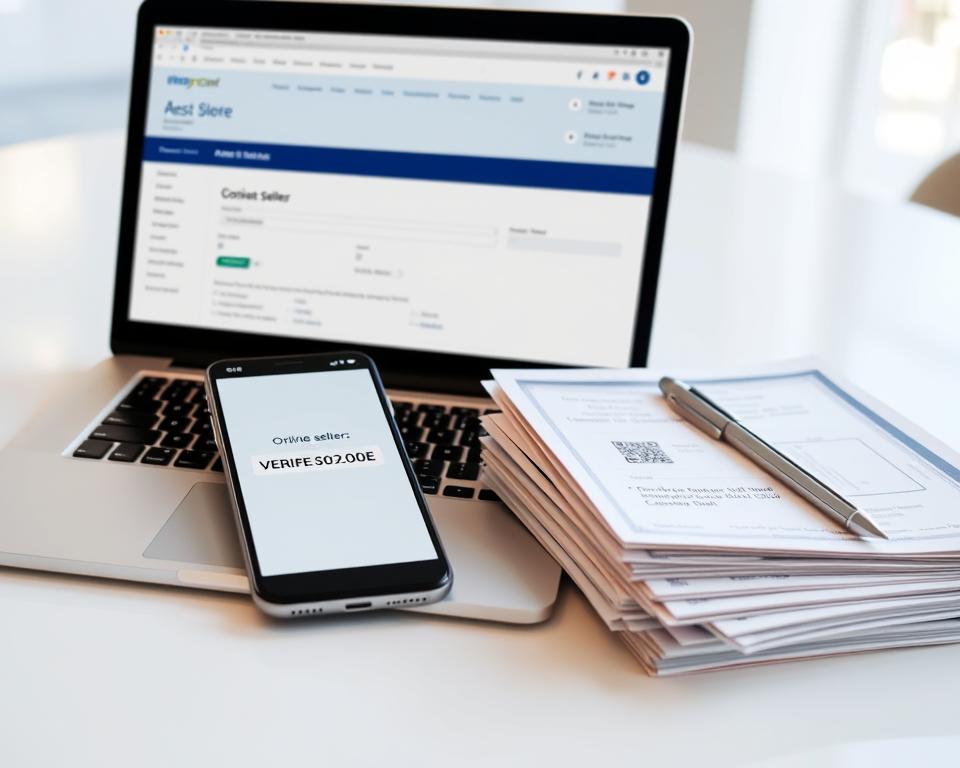The world of e-commerce has changed a lot, with big names like Amazon and Etsy leading the way. Many entrepreneurs and businesses want to follow in their footsteps. They aim to make their own online marketplaces successful, tapping into the growing trend of digital shopping. In this guide, we’ll show you how to build an e-commerce marketplace that can compete with Amazon and Etsy.
To make a successful e-commerce marketplace, you need to understand a lot. This includes the business model, the market, and the tech needed. You have to think about everything, from the right marketplace model to payment systems and making the user experience great. Every detail matters to attract and keep both buyers and sellers.
Table of Contents
Key Takeaways
- Understand the different types of e-commerce marketplace models and their revenue generation strategies.
- Identify the essential features and functionalities needed to create a competitive e-commerce platform.
- Develop a robust technical infrastructure and user interface that enhances the shopping experience.
- Implement secure payment processing, seller onboarding, and order management solutions.
- Leverage marketing and SEO strategies to drive growth and attract a loyal customer base.
Understanding the E-commerce Marketplace Business Model
The e-commerce world is changing fast, with the marketplace model leading the way. It offers many chances for both entrepreneurs and shoppers. Each type, like B2B marketplace, B2C marketplace, or C2C marketplace, has its own benefits and challenges.
Different Types of Marketplace Models
The e-commerce world has many marketplace models. Each one meets different needs and wants. Here are some of the most well-known:
- B2B Marketplace: These sites help businesses buy from a wide range of suppliers. They often get better prices.
- B2C Marketplace: These sites let businesses sell directly to consumers. They offer a huge variety of products and services.
- C2C Marketplace: Here, people sell to each other. It’s a place where individuals can buy and sell things.
Revenue Generation Strategies
Marketplaces make money in different ways. Two main methods are:
- Commission-based Model: The platform makes money by taking a cut from each sale. This can be a small percentage or more.
- Subscription Model: Some platforms charge sellers a regular fee. This lets them use the platform’s services.
Key Market Players Analysis
Some big names lead the e-commerce marketplace world. Each has its own strengths and plans. Here are a few:
| Marketplace | Model | Revenue Generation | Market Share |
|---|---|---|---|
| Amazon | B2C, C2C | Commission-based | 38.7% |
| Etsy | C2C | Commission-based, Subscription | 2.6% |
| eBay | C2C | Commission-based | 6.1% |
Essential Features for Your E-commerce Marketplace Platform
Building a successful e-commerce marketplace needs a solid set of core features. These features help both buyers and sellers, making the platform easy to use and grow. They ensure a smooth experience for everyone involved.
A user registration process is key. It lets customers sign up and manage their accounts safely. This builds a loyal customer base over time.
The product listings section is where sellers show off their products. They provide detailed descriptions, images, and prices. A good design makes it easy for customers to find what they need.
- Intuitive product search and filtering options
- Comprehensive product details and imagery
- Seamless integration with seller inventory management
The shopping cart is crucial. It lets customers add and review items before checking out. It should clearly show order details and allow for easy changes.
The checkout process is where customers make their purchases. It must be secure and easy to use. Options for payment, tracking orders, and clear delivery info are vital.
A seller dashboard is also important. It helps vendors manage their inventory, track sales, and see customer feedback. This lets sellers improve their marketing and stay strong on the platform.
| Feature | Description |
|---|---|
| User Registration | Secure sign-up process for customers to create and manage their accounts |
| Product Listings | Intuitive interface for sellers to showcase their offerings with detailed information and imagery |
| Shopping Cart | Functionality that allows customers to collect and review their desired items before checkout |
| Checkout Process | Streamlined and secure payment options, real-time order tracking, and transparent delivery information |
| Seller Dashboard | Comprehensive tool for vendors to manage their inventory, track sales, and monitor customer feedback |
By adding these key features, you can make a strong and easy-to-use e-commerce marketplace. These features help meet the needs of both buyers and sellers. They are key to building a successful online marketplace and growing your business over time.
“The key to building a thriving e-commerce marketplace is to focus on creating a seamless and enjoyable experience for both buyers and sellers.”
Technical Requirements and Technology Stack Selection
Creating a successful e-commerce site like Amazon or Etsy needs the right tech stack. You must pick the best frontend, backend, and database solutions. These choices power your site’s main features.
Frontend Development Technologies
For frontend work, React and Angular are top picks. Both use component-based designs for better user experiences. React is known for its ease and flexibility, while Angular suits bigger projects with its full toolset.
Backend Infrastructure Choices
For the backend, Node.js and Ruby on Rails are key options. Node.js is great for scalable, real-time apps with its unique model. Ruby on Rails is loved for quick prototyping and agile work with its easy setup.
Database Management Systems
Choosing a database is vital for e-commerce sites. MongoDB is perfect for handling unstructured data, like product info. PostgreSQL is better for structured data, like orders and payments, with its advanced features.
Choosing tech for your e-commerce site depends on your needs and team’s skills. By understanding each tech’s strengths, you can create a strong, scalable site that serves your customers and sellers well.
User Interface and Experience Design Principles
Creating a great e-commerce site needs a deep grasp of UI and UX design. These are key to making a site that looks good and is easy to use. Your customers should find it simple to navigate and find what they need.
Responsive design is a must in today’s world. People use different devices to access websites. Your site must look good and work well on all screens. This makes your site more attractive and easier to use.
Intuitive navigation is also vital. Your customers should be able to find products and complete their shopping easily. A good navigation system, clear labels, and simple interactions make shopping better.
The visual hierarchy of your site is crucial too. It helps guide users through your site smoothly. Use big fonts, bold text, and place important info well to make your site easy on the eyes.
Don’t forget about accessibility. Make sure your site is open to everyone, including those with disabilities. This makes your site better for more people and follows important rules.
By following these UI and UX design rules, you can make a site that looks great and is easy to use. This will make your customers happy and keep them coming back.
“Exceptional user experience is the key to building a successful e-commerce marketplace that stands out in a crowded digital landscape.”
Setting Up Secure Payment Processing Systems
In the world of e-commerce, keeping payments safe is key. First, you need a reliable payment gateway to handle transactions smoothly. Then, strong security measures and PCI DSS compliance are vital to protect your customers’ financial info.
Payment Gateway Integration
Choosing the right payment gateway is essential for a secure checkout. Options like PayPal, Stripe, and Authorize.net make it easy to accept various payments. This includes credit/debit cards, digital wallets, and more.
Security Protocols and Compliance
High security standards are a must. SSL encryption and tokenization protect data and sensitive info. Also, following PCI DSS shows you’re serious about security and trust with your customers.
Transaction Fee Structures
- Percentage-based fees: Charge a percentage of each transaction, typically ranging from 1.5% to 3.5%.
- Flat-rate fees: Implement a fixed fee per transaction, often between $0.20 and $0.30.
- Tiered pricing: Offer different fee structures based on transaction volume or other criteria, incentivizing larger sellers.
- Subscription-based fees: Charge a monthly or annual fee for access to the marketplace, with reduced or waived transaction fees.
| Feature | Importance | Benefit |
|---|---|---|
| PCI DSS compliance | High | Ensures secure handling of sensitive payment data and reduces the risk of fraud |
| SSL encryption | High | Protects data in transit, safeguarding customer information and transactions |
| Tokenization | High | Replaces sensitive data with unique identifiers, reducing the risk of data breaches |
| Fraud detection | High | Identifies and prevents fraudulent activities, protecting both sellers and buyers |
By setting up secure payment systems, you build trust with your customers. You also make transactions smoother and protect your marketplace from fraud and data breaches.
Seller Onboarding and Management Process
Streamlining the seller onboarding and management process is key for any e-commerce marketplace’s success. To ensure a smooth experience, platforms must have strong seller verification, product approval, and seller support systems.
The onboarding process starts with seller verification to check if the seller is legitimate and follows marketplace rules. This includes verifying the seller’s identity, business registration, and sales history. By doing this, the platform can build trust with its users.
- Implement a thorough seller verification process, including identity, business, and sales history checks.
- Establish clear guidelines for product approval, ensuring that all listed items meet the marketplace’s quality and safety standards.
- Set fair and transparent commission rates that incentivize sellers to offer competitive prices and provide excellent customer service.
- Offer dedicated seller support channels, such as helpdesk, knowledge base, and community forums, to address seller inquiries and concerns promptly.
| Feature | Description |
|---|---|
| Seller Verification | Comprehensive checks on seller’s identity, business registration, and sales history to ensure legitimacy and compliance. |
| Product Approval | Rigorous review and approval process for all products listed on the marketplace, maintaining quality and safety standards. |
| Commission Rates | Fair and transparent commission structure that incentivizes sellers to offer competitive prices and excellent customer service. |
| Seller Support | Dedicated channels for sellers to access information, ask questions, and resolve issues, ensuring a positive experience. |
By focusing on these key elements, e-commerce marketplaces can create a trusted and thriving seller community. This leads to growth and success for the platform.
Building a Robust Search and Filter System
In the world of e-commerce, a strong search and filter system is key. It helps users find products easily. By using Elasticsearch, marketplaces can offer search results that match what users want.
Search Algorithm Development
Creating a good search algorithm is vital. It makes sure search results are relevant and personal. Features like autocomplete and spell-checking make the search better. This helps users find what they need fast.
Filter Implementation Strategies
A good filter system is also important. It lets users narrow down their search. With faceted search, users can filter by price, category, and more. This makes browsing easier and helps find the right product.
| Feature | Description | Benefits |
|---|---|---|
| Elasticsearch | A powerful open-source search and analytics engine | Enables fast and accurate search capabilities, faceted search, and advanced relevance ranking |
| Autocomplete | Suggests search terms as users type | Enhances user experience, increases search efficiency, and reduces typos |
| Faceted Search | Allows users to filter and navigate products by various attributes | Improves product discovery, increases conversion rates, and provides valuable user insights |
With a solid search and filter system, e-commerce sites can help users find what they need. This leads to more engagement, higher sales, and a better user experience.
Implementing Rating and Review Systems
In the fast-paced world of e-commerce, ratings and reviews are key. They help build trust and credibility for sellers and products. A good rating and review system lets customers make smart choices based on others’ experiences.
Setting up a strong rating and review system needs careful thought. First, clear rules for review moderation are vital. This ensures the content is real, relevant, and helpful. It boosts the user experience and keeps the marketplace honest.
| Benefits of User-Generated Content | Importance of Trust Indicators |
|---|---|
|
|
Also, making the review and rating systems easy to use is important. This lets users share their thoughts and find useful info quickly. A simple interface and clear steps encourage more people to join in and build a community.
In the end, a solid rating and review system is a smart move. It leads to more user content, social proof, and trust indicators. These are all key for an e-commerce site’s success over time.
Order Management and Fulfillment Solutions
Efficient order management and fulfillment are key for e-commerce success. Today, customers want easy order tracking and reliable shipping. Marketplace platforms can improve their fulfillment by using advanced solutions and working with shipping carriers.
Order Tracking Features
Good order tracking features keep customers updated on their orders. They get real-time updates on processing, dispatch, and delivery. By working with top shipping carriers’ APIs, marketplaces can give live tracking info. This lets customers plan their deliveries confidently.
Shipping Integration Options
Having many shipping options is vital for attracting and keeping sellers and buyers. By working with various shipping carriers, marketplaces offer sellers flexible choices, including dropshipping. This lets sellers focus on their business while the marketplace handles delivery.
| Shipping Carrier | Delivery Time | Shipping Rates | Tracking Integration |
|---|---|---|---|
| USPS | 2-7 business days | $5 – $20 | Yes |
| FedEx | 1-3 business days | $10 – $30 | Yes |
| UPS | 1-5 business days | $8 – $25 | Yes |
Offering different shipping options meets the needs of sellers and customers. This ensures a smooth order management and fulfillment experience.
Marketing and SEO Strategies for Marketplace Growth
To grow a successful e-commerce marketplace, you need a solid marketing plan. This plan should include content marketing, social media, email campaigns, and SEO. These strategies help attract more customers and grow your platform.
Content marketing is key. It involves creating useful and engaging content. This content can be blog posts, guides, or videos. It helps your marketplace stand out and build trust with users.
Social media is also crucial. Use platforms like Facebook and Instagram to show off your marketplace. Share success stories and interact with your audience. This helps grow your community and brand.
Email campaigns are another important tool. They help keep users engaged and informed. Use them to promote new features and products. Personalize your emails based on user behavior for better results.
SEO is vital for attracting organic traffic. Use keyword research and on-page optimization to improve your search rankings. This brings more potential customers to your site.
By combining these strategies, you can drive growth and success. A well-planned approach to marketing and SEO is essential for your e-commerce marketplace.
Mobile App Development Considerations
The world of e-commerce is always changing. For businesses, having a strong mobile presence is key to reaching more people and keeping customers engaged. Choosing between native and hybrid app development is a big decision. They also need to focus on app store optimization to make their apps easy to find and download.
Native vs. Hybrid Development
Deciding between a native iOS app or Android app and a hybrid app built with React Native or Flutter is important. Native apps work best on their respective platforms, offering top performance and user experience. However, they need separate teams and take longer to make.
Hybrid apps can run on many platforms with one codebase. They’re quicker to develop but might not match native apps in performance and features.
App Store Optimization Tips
- Do deep keyword research to find the best search terms for your iOS app and Android app.
- Make your app titles, descriptions, and visuals catchy. They should highlight your marketplace’s unique benefits and features.
- Ask users to leave reviews and ratings to improve your app’s app store rankings and trustworthiness.
- Keep an eye on your app’s details and content. Update them often to meet user needs and market trends.
By weighing the pros and cons of native vs. hybrid apps and using smart app store optimization, e-commerce owners can create great mobile experiences. This leads to more downloads, use, and sales.
Legal Requirements and Compliance Measures
Starting an e-commerce marketplace means you must follow certain laws and rules. You need to write detailed terms of service and strong privacy policies. You also have to follow data protection laws like the General Data Protection Regulation (GDPR) and the California Consumer Privacy Act (CCPA).
Protecting intellectual property is key for e-commerce sites. You must have clear rules for using copyrights, trademarks, and patents. These rules apply to your site and the items sold on it.
| Legal Requirement | Key Considerations |
|---|---|
| Terms of Service | – Clearly define the rules and guidelines for users – Outline seller and buyer responsibilities – Establish dispute resolution mechanisms |
| Privacy Policy | – Explain how customer data is collected, used, and protected – Ensure compliance with GDPR and CCPA regulations – Obtain necessary user consent for data processing |
| Intellectual Property Protection | – Establish policies for copyright, trademark, and patent protection – Implement processes to address infringement claims – Educate sellers on intellectual property rights |
By tackling these legal and compliance issues, you can make your e-commerce site safe and trustworthy. This builds confidence with both buyers and sellers.
Analytics and Performance Monitoring Tools
In the world of e-commerce marketplaces, data is key to success. Powerful analytics and monitoring tools help you understand your platform’s performance. Google Analytics is a top choice, offering many features to improve your marketplace.
Key Performance Indicators
Measuring your marketplace’s success involves a few important KPIs. These include:
- Conversion rate optimization: This tracks visitors who make a purchase or sign up.
- Customer lifetime value: It shows the average revenue from each customer over time.
- Cohort analysis: This looks at user behavior and retention by marketing channel.
Data Analysis Methods
To get valuable insights from your data, use different analysis methods. These include:
- Descriptive analytics: This summarizes and visualizes key metrics to understand your marketplace.
- Predictive analytics: It uses models to forecast future trends and behavior.
- Prescriptive analytics: Advanced algorithms suggest actions to improve your marketplace.
By watching your KPIs and making data-driven decisions, you can manage and grow your marketplace. This keeps it competitive and profitable over time.
Scaling Your Marketplace Infrastructure
As your e-commerce marketplace grows, scaling your infrastructure is key. This ensures performance, reliability, and quick responses. Cloud hosting is a great strategy, offering scalable resources, high availability, and cost savings.
Load balancing helps by spreading the workload across many servers. This keeps your site running smoothly, even when it’s busy. Caching strategies also boost performance by cutting down on backend work and speeding up user responses.
Using a microservices architecture adds flexibility and scalability. It breaks your app into smaller, independent services. This lets you scale each part separately, making your system more resilient and faster to update.
- Leverage cloud hosting for scalable resources and high availability
- Implement load balancing to distribute workload across multiple servers
- Utilize caching strategies to optimize performance and reduce backend load
- Adopt a microservices architecture for greater flexibility and scalability
By planning and implementing these strategies, your e-commerce marketplace can handle more users and transactions. This lets your business grow and succeed in the competitive online market.
Customer Support and Dispute Resolution Systems
In the world of online shopping, great customer support and strong dispute systems are key. They help build trust, keep customers coming back, and make shopping smooth. When buyers and sellers deal with each other on your site, having good systems to handle problems is crucial.
A good ticketing system is essential for a customer-focused marketplace. It lets users report issues easily, so each problem gets solved quickly. Adding live chat support makes your service even better. It offers quick help and helps you connect with your users better.
Also, having strong buyer protection policies is important. These policies should clearly explain how to handle returns, refunds, and disputes. This gives customers peace of mind. If problems do come up, a fair mediation process helps find solutions that everyone agrees on.
- Implement a user-friendly ticketing system to manage customer inquiries and complaints
- Offer live chat support for immediate assistance and personalized interactions
- Establish clear buyer protection policies to instill confidence in your marketplace
- Develop a fair and transparent mediation process to resolve disputes effectively
By focusing on customer support and solving disputes, you can create a successful online shopping site. Investing in these areas improves the shopping experience and helps your site grow and stay strong.
Conclusion
In the world of e-commerce, success depends on a mix of planning, technology, and knowing what customers want. This guide has covered the key points for building a successful e-commerce marketplace. It’s all about creating a place where both buyers and sellers thrive.
Building an e-commerce marketplace is tough but rewarding. It involves understanding business models, making money, and creating good search and review systems. With the right knowledge, entrepreneurs and businesses can overcome challenges and grow their online stores.
The digital world keeps changing, and technology is key to success. By using the strategies from this article, businesses can build a marketplace that excites and satisfies customers. It’s all about staying ahead and meeting the needs of today’s shoppers.



















